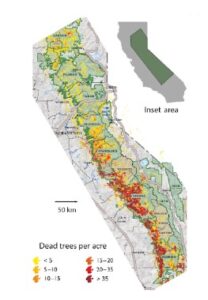A review of the challenges and inter-disciplinary solutions to understanding tree drought physiology and management approaches to mitigate impacts.

Figure: Tree mortality in the Sierra Nevada Mountains of California from 2014-2017. Credit: US Forest Service.
The Science
Droughts of increasing severity and frequency are a primary cause of forest mortality. Yet, fundamental knowledge gaps regarding the complex physiology of trees limit the development of more effective management strategies to mitigate drought effects on forests. Here, a group of experts from around the world highlight basic research needs to better understand tree drought physiology and how new technologies and interdisciplinary approaches can be used to address them. Their discussion first identifies key research questions regarding how trees respond to drought, and then they identify opportunities to enhance or develop new strategies for managing drought effects on forests. They conclude with a discussion of the need for co-producing research with land managers.
The Impact
This paper addresses the accelerating challenge of drought-induced tree mortality, which has large, negative environmental, societal, and economic impacts. This information provides a roadmap to research and management that can maximize forest health and the subsequent provision of resources such as timber, clean water, animal habitat, and biodiversity. A large discrepancy exists between the magnitude of societal and economic costs of tree mortality relative to the funding support for research and management. Engaging local communities in understanding and mitigating drought impacts on forests is a critical step towards successful adaptation.
Summary
The paper emphasizes the urgency of bridging research gaps in tree drought physiology to inform better forest conservation and management practices under climate change. It calls for increased investment in interdisciplinary studies, new technologies, and collaborations to improve forest resilience. The authors first review critical challenges in our understanding and application of tree genetics, hormones, wood properties, legacy impacts, and soil microbes to drought-mitigation strategies. They then review key large-scale management strategies that show promise for sustaining forests under future droughts, including genetic selection, assisted migration, stress priming, microbiome manipulations, and advanced monitoring and prediction. They conclude with an emphasis on the large value of cross-disciplinary efforts between scientists, land managers, and local communities to effectively develop and implement protection strategies.
DOE PM Contacts
- Daniel Stover, Environmental System Science Program, daniel.stover@science.doe.gov
Research Contacts
- Nate McDowell, nate.mcdowell@pnnl.gov, Pacific Northwest National Laboratory
Funding
Nate McDowell was supported by the Next Generation Ecosystem Experiment-Tropics, a multi-institutional project supported by the Department of Energy, Office of Science, Biological and Environmental Research as part of the Environmental System Science Program. This synthesis was an international effort supported by a number of different agencies around the world.
Publication
Groover, A., Holbrook, N.M., Polle, A., Sala, A., Medlyn, B., Brodersen, C., Pittermann, J., Gersony, J., Sokołowska, K., Bogar, L. and McDowell, N., 2024. Tree drought physiology: critical research questions and strategies for mitigating climate change effects on forests. New Phytologist.
Related Links
https://ngee-tropics.lbl.gov/